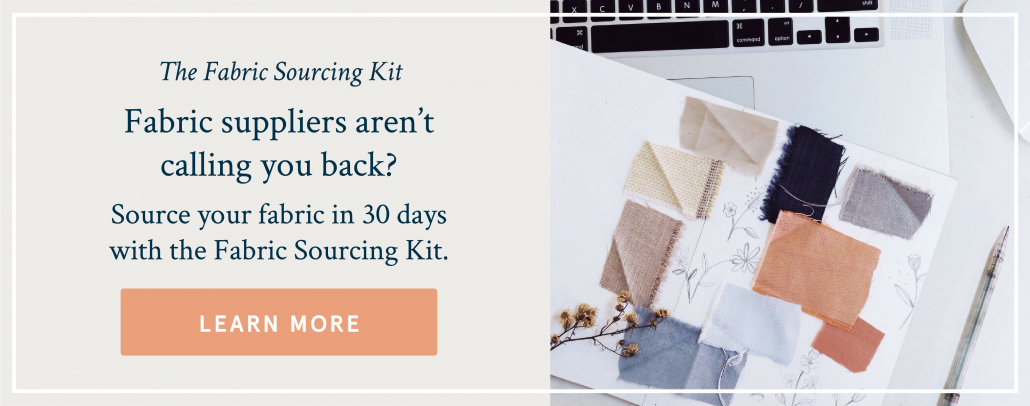Podcast Ep. 01: How to Start a Sustainable Fashion Brand
Listen on Apple Podcasts | Listen on Spotify
You want to start a sustainable fashion brand that’s ethically manufactured and eco-friendly, that’s why you’re here. The question is: Where do you start? What does it mean to be “sustainable” and what are some of the most important things you should keep in mind as you build your brand? That’s what I’m going to share with you in today’s episode.
Resources mentioned in this episode:
TRANSCRIPT
So, you want to start a sustainable fashion brand that’s ethically manufactured and eco-friendly, that’s why you’re here. The question is: Where do you start? What does it mean to be “sustainable” and what are some of the most important things you should keep in mind as you build your brand? That’s what I’m going to share with you in today’s episode.
Okay, so you know you don’t want to start a traditional fashion brand — you want to create a business that is socially conscious and helps to provide a solution to the “fast fashion problem.” But how do you do that? In today’s episode I’m going to go over the four main factors to consider when building your sustainable fashion brand from the ground up. These are the foundational pillars, so to speak, to incorporate into your business model.
First, we have your Fabrics & Materials. From a supply chain perspective, this is the first thing you want to consider when conceptualizing your brand. You want to look for natural fibers, recycled or upcycled materials and stay away from petroleum-based synthetics like polyester, spandex and nylon. These synthetic fabrics can take up to 200 years to decompose in a landfill and the fast fashion industry is churning out polyester clothing faster than you can say “climate change contributor” so it’s really important to stay away from further contribution to this problem.
So where do you start on this step? First, identify what type of fabric will be the best fit for your product(s) and then find out if there’s a more sustainable version of that fabric.
For example: If you know you want to use 100% cotton, then start researching organic cotton. If you know you need a soft drapey fabric like rayon, then start exploring tencel or lyocell plant-based options. Basically, you want to find out what the “sustainable match” is to your fabric needs.
Where do you find sustainable fabrics? Thankfully, there are fabric suppliers all around the world that are now specializing in natural and environmentally-friendly fabrics. Finding them can sometimes take a simple google search, but for a more comprehensive list consider some of the sustainable fabric databases available to you like Common Objective, CFDA and of course, my company Factory45.
If you need a little more direction on what types of sustainable fabrics exist and the pros and cons of each, check out The Fabric Sourcing Kit, one of our digital resources that helps you source your fabric in 30 days – it also has a list of my top 10 fabric suppliers that sell sustainable fabrics.
The second thing you need to consider in creating a sustainable fashion brand, and just as important as your fabric and materials, is the integrity of your Design.
One of the main ethos of sustainable fashion is working to not only eliminate waste but also, not make more waste that will just end up in landfills. So, you have to think of the end life of your product. Where will it end up when your customer is done with it? Can the fabric be composted? Can it be recycled? Do you have a buy back or repairs program?
You’ll also want to consider making your designs seasonless, trendless and timeless. Sustainable fashion is all about creating garments that can be worn for years and years to come. They won’t go “out of style,” they’re made to last and they don’t try to keep up with the fast fashion cycle of constant trends.
Because the truth is, the design of your product has to come first. It needs to fit well, be well-made and make your customer feel good wearing it. You can’t depend on sustainability as a marketing method or a way of getting someone to buy your product. The design and quality of the garment has to sell itself first.
The third component to creating a sustainable fashion brand is your Manufacturing
One of my favorite methods of approaching manufacturing is by pre-selling your product before you go into production. Instead of creating a bunch of inventory upfront and not knowing if you’ll sell anything or if it will just sit in a warehouse, you can pre-sell your products on sites like Shopify, Kickstarter or iFundWomen to test your product at market and see if it’s something people actually want to buy.
Not only does this help to eliminate possible waste, but it also gives you a chance to generate revenue upfront that you can then re-invest into your production run. Your first customers are essentially financing your production run for you.
This is the main launch strategy that we teach in Factory45 and since 2014 we’ve seen fashion brands across all niches and target markets successfully launch their brands by pre-selling. If you’re interested in learning more about launching your brand with us in this low-risk, cash-forward way, book a call with us to learn more at factory45.co.
When it comes to the actual factory you’re going to work with, start by looking for manufacturing partners within driving distance (or a short flight) of where you live. When researching production partners, pay special attention to pages outlining fair labor policies, minimum wage and any certifications they have available.
And the fourth thing to consider in creating a sustainable fashion brand is your packaging.
Whenever possible you want to keep your packaging as minimal as you can, while still protecting the product from shipping and weather. That means avoiding plastic wrap, bubble wrap, styrofoam peanuts and other artificial, synthetic and non-recyclable materials.
You’ll also want to make sure you’re using recycled or compostable materials in the boxes and mailers you use. We provide an entire database of eco-friendly packaging options in the Factory45 program, so I know there are plenty out there.
Here’s the thing to remember when you’re first starting out in the sustainable fashion space: there are ways to test the market, raise money upfront and get customers before you even produce any inventory. That’s right, customers first, money second and production third. This is truly the most sustainable way to start a product-based business because you’re not creating anything before you know you have customers to sell to. This is the strategy we’ve been teaching since 2014 and it’s only becoming more and more popular from the startup brands all the way up to the big established brands.
So, as a summary and recap: you now have the four pillars of a sustainable fashion brand: sustainable fabric & materials, design integrity, ethical manufacturing and sustainable packaging. Of course there is so much more that goes into launching a successful brand, but these are the first four things I want you to start thinking about as you begin to build out your business model. In next week’s episode we’ll start getting things on paper by writing your business plan.
I hope this was a helpful baseline to start with and I’m excited to dive into it more in coming episodes. Make sure to hit subscribe wherever you get your podcasts and check out the resources I’ve linked in the description below. See you back here for episode 2!



